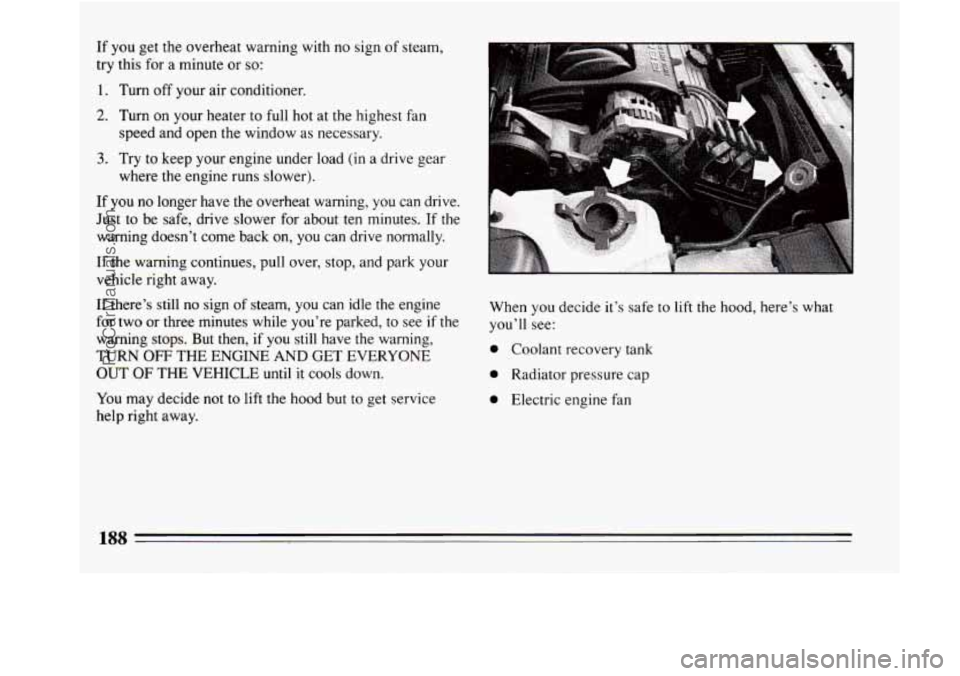Page 189 of 308
Engine Overheating
You will find the coolant temperature gage on your
instrument panel.
You may also find a low coolant
warning light.
If Steam Is Coming From Your Engine
I NOTICE:
If your engine catches fire because you keep
driving with no coolant, your vehicle can be
badly damaged. The costly repairs would not be
covered by your warranty.
If No Steam Is Coming From Your Engine
If you get the overheat warning but see or hear no
steam, the problem may not be too serious. Sometimes
the engine can get a little too hot when you:
Climb a long hill on a hot day.
Stop after high speed driving.
Idle for long periods in traffic.
0 Tow a trailer.
187
ProCarManuals.com
Page 190 of 308

If you get the overheat warning with no sign of steam,
try this for a minute or
so:
1. Turn off your air conditioner.
2. Turn on your heater to full hot at the highest fan
speed and open the window as necessary.
3. Try to keep your engine under load (in a drive gear
where the engine runs slower).
If
you no longer have the overheat warning, you can drive.
Just to be safe, drive slower for about
ten minutes. If the
warning doesn’t come back on,
you can drive normally.
If the warning continues, pull over, stop, and park your
vehicle right away.
If there’s still no sign of steam, you can idle the engine
for two or three minutes while you’re parked, to see if the
warning stops. But then, if you still have the warning,
TURN OFF THE ENGINE AND GET EVERYONE
OUT OF THE VEHICLE until it cools down.
You may decide not
to lift the hood but to get service
help right away. When you
decide it’s safe to lift
the hood, here’s what
you’ll see:
0 Coolant recovery tank
0 Radiator pressure cap
0 Electric engine fan
ProCarManuals.com
Page 191 of 308
If the coolant inside the coolant recovery tank is boiling,
don’t do anything else until it cools down. The coolant level should be
at or above the
“COLD’
mark. If it isn’t, you may have a leak in the radiator
hoses, heater hoses, radiator, water pump or somewhere
else in the cooling system.
I NOTICE:
I
Engine damage from running your engine
without
coolant isn’t covered by your warranty. I
If there seems to be no leak, check to see if the electric
engine fan is running.
If the engine is overheating, the
fan should be running.
If it isn’t, your vehicle needs
service.
ProCarManuals.com
Page 192 of 308
How to Add Coolant to the Coolant
Recovery .Tank
If you haven’t found a problem yet, but the coolant level
isn’t at or above the “COLD” mark, add a
50/50 mixture
of clean water (preferably distilled) and a proper
antifreeze at the coolant recovery tank. (See “Engine
Coolant’’ in the Index for more information about
the
proper coolant mix.)
I NOTICE:
In cold weather, water can freeze and crack the
engine, radiator, heater core and other parts. Use
the recommended coolant.
190
ProCarManuals.com
Page 193 of 308
I A CAUTION:
You can be burned if you spill coolant on hot
engine parts. Coolant contains ethylene glycol
and
it will burn if the engine parts are hot
enough, Don’t spill coolant on a hot engine.
When the coolant in the coolant recovery tank is at or
above the
“COLD” mark, start your vehicle.
If the overheat warning continues, there’s one more
thing you can try.
You can add the proper coolant mix
directly to the radiator but be sure the cooling system is
cool before you do it.
A CAUTION:
Steam and scalding liquids from a hot cooling
system can blow out and
burn you badly. They
are under pressure,
and if you turn the radiator
pressure cap
-- even a fittle -- they can come out
at
high speed. Never turn the cap when the
cooling system, including the radiator pressure
cap, is
hot.
CAUTION: (Continued)
CAUTION: (Continued)
Wait for
the cooling system and radiator
pressure cap to cool
if you ever have to turn the
pressure cap.
d
I
191
ProCarManuals.com
Page 194 of 308
How to Add Coolant to the Radiator
NOTICE:
Your engine has a specific radiator fill procedure.
Failure to follow this procedure could cause your
engine to overheat and
be severely damaged.
. ..,
1. You can remove the
radiator pressure cap when
the
cooling system,
including the
radiator pressure
cap and upper
radiator hose, is no
longer hot.
2.
Turn the pressure cap slowly to the left until it first stops.
(Don’t press down while turning the pressure cap.)
If you hear a hiss, wait for that to stop.
A hiss means
there
is still some pressure left.
Then keep turning the pressure cap, but now push
down as you turn
it. Remove the pressure cap.
192
ProCarManuals.com
Page 195 of 308
3. After the engine cools, open the coolant air bleed
valve
or valves.
3.1L
V6 (VIN Code T or M): There are two bleed
valves. One
is located on the thermostat housing.
The
other is located on the thermostat bypass tube.
193
ProCarManuals.com
Page 196 of 308
1
S
3.8L V6 (VIN Code L27): There is one bleed valve.
It is located on the thermostat housing.
:'
4. Fill the radiator with the proper
mix, up to the base
of the filler neck.
.,
If you see a stream of coolant coming from an air
bleed valve, close the valve. Otherwise, close the valve(s) after the radiator
is filled.
5. Rinse or wipe any spilled coolant from the engine
and compartment.
194
ProCarManuals.com